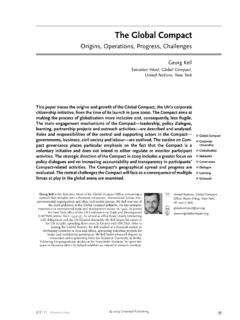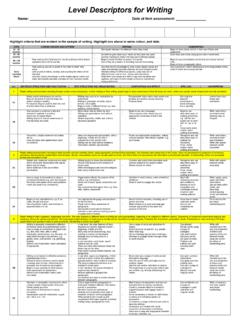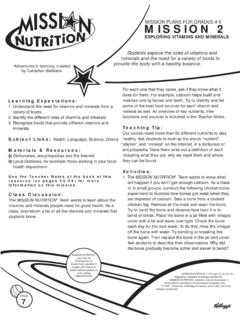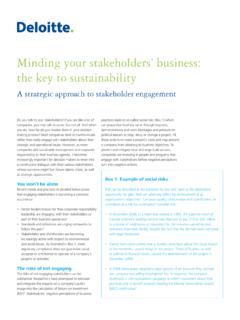Transcription of SEVEN ACTIVITIES TO ENGAGE SYSTEMS THINKING - Arne …
1 SEVEN ACTIVITIES TO ENGAGE SYSTEMS THINKING . Arne Collen Saybrook Graduate School and Research Center 450 Pacific, San Francisco, CA 94133 USA. Email: Gianfranco Minati Italian Association for Research on SYSTEMS 10,Via Jenner, 20159 Milano, Italy. Email: Abstract SEVEN ACTIVITIES to ENGAGE SYSTEMS THINKING are described, then discussed in a dialogue format. The SEVEN ACTIVITIES involve the creation and discussion of (1) sets in contrast to SYSTEMS , (2) a simple device to mix colored waters, (3) harmony in music, (4) story- telling, (5) playing in contrast to designing a game, (6) a language game, and (7) a strategy that selects in contrast to combines. Discussion relates SYSTEMS THINKING via these ACTIVITIES to education, human betterment, human SYSTEMS inquiry, pedagogy, and technology. Keywords: education, learning, pedagogy, SYSTEMS THINKING . 1. Introduction The purpose of our paper is to describe and discuss SEVEN ACTIVITIES in which persons can ENGAGE in and experience SYSTEMS THINKING .
2 As a general source of further information about these ACTIVITIES , see Minati and Collen (1997). Our paper consists of systematic coverage of each activity in turn. First, we describe the activity and second, pose for pedagogical application questions for discussion to foster reflection and consolidation of SYSTEMS THINKING as an experience and learning activity. Third, we discuss our views about the activity in a dialogue format, particularly in regard to such themes as informed decision making, general education, pedagogical strategy, human inquiry, and the use of technology. Our dialogue on this subject matter is especially intended to encourage more consideration of the relevance of SYSTEMS THINKING for education and pedagogy of our sons, daughters, and their peers---the next generation. Regarding their application, the ACTIVITIES are not restricted to the order of presentation in this paper. They may be used in any order the pedagogue believes will implement their effective application.
3 And each activity may be used alone. Although some of the 1. SEVEN ACTIVITIES to ENGAGE SYSTEMS THINKING discussion questions may seem to imply more involved discussion as the paper develops, it is not to suggest a delimitation to their application. Of course the questions may be modified and enumerated for every activity. Furthermore, the questions under one activity may prove helpful in discussion of another activity. Finally, our dialogue is intended to provoke especially those who would lead these ACTIVITIES . We believe that discussion leaders may find our exchange about SYSTEMS ideas helpful to their planning and conduct of these ACTIVITIES . 2. Set and system Description of the Activity Make two lists. One list has the overarching title SET, and the other list has the title SYSTEMS . Write out several entries under each title. For example, write down the set of ingredients to make a cake. Then write down what to do to mix and bake them so that they transform into a system .
4 For another example, write down the set of your favorite football players. Then write down what they must to do to transform into a football team. Compile two lists of several entries. Each entry has its set on one side and its corresponding system on the other side. Discussion Questions 1. What distinguishes a set from a system , and the converse? 2. What happens to transform a set into a system ? What happens to change a system into a set? Dialogue Arne Collen (AC): This activity really highlights the dynamic qualities of SYSTEMS that are vividly absent in the more static qualities of set. It also can inform the player about the shift in THINKING necessary to legitimate a system . That is, the salient elements one defines to initiate conceptually a system in thought is certainly one cognitive act, but it is comprehending the nature of their interactions that enables the player to understand them as a system . Gianfranco Minati (GM): This activity helps the player to focus on the transformation process identifying the forces able to transform a set of elements into a system .
5 Speaking about the elements of a set, what is easy to identify are the relationships among them. One element may be double another one in weight or in dimension and may come before or after another one regularly, and so on. Making reference to what you just said, the reference is to static relationships or having constant or predictable changing. The process of transformation into a system emerges when interaction among elements changes the properties of the set. The definition of interaction helps to identify the relevance of this point: we have an interaction among elements when the behavior of one modifies the behavior of another one. In systemics the reference is to dynamics. 2. SEVEN ACTIVITIES to ENGAGE SYSTEMS THINKING 3. Mixing Colored Waters Description of the Activity Fill three large glasses with colored water. Blue, red, and yellow food dyes may serve this purpose. Very slowly mix together in equal proportion any two colors on a plate or in an empty glass. Specifically, mix blue and red, blue and yellow, and red and yellow.
6 Observe the changes in color swirls as the emergent color appears in the mixture. Now continue the procedure, but without duplication, using the six glasses. Mix only two different glasses at a time. The pairs should include the mixture of not only different colors (for example: blue-red with yellow), but also color repetition (for example: blue- red with red). Observe the changes in color. Finally mix in equal proportions the three original glasses of color, and observe the change in color. Discussion Questions 1. What can mixing colors tell us about the interactions of elements of a system ? 2. How does a system create and destroy elements that do not at first seem part of it? Dialogue AC: Given the rudimentary separation and paired mixing of colors, I do not think of this activity as engendering SYSTEMS THINKING per se, but it does help us to comprehend a stepping stone in the direction of SYSTEMS THINKING as well as bring into the foreground of our THINKING the importance of emergence to SYSTEMS THINKING .
7 Emergence is an important quality of SYSTEMS , but is it an essential feature of only SYSTEMS ? When the parts interact, we can expect something more to come of it. At first, it would seem that the emergent quality is not present in a set. Perhaps we can think of it as a potentiality, should the elements of a set be made to interact. It is only through the interacting that the added feature becomes visible. Thus, this activity sparks some skepticism and wonder. By the mere mixing of two elements, in this case colors, can we say it is a system ? Can an emergent phenomenon occur within a set, or is it a quality characteristic and reserved only for a system ? GM: I think the experiment helps the player to identify some crucial points relevant to SYSTEMS THINKING . First is the difference between to add and to combine. Adding half liter of water to another half liter of water brings the result to have one liter of water. The reference is to relationships as it is to sets in the previous activity Sets and SYSTEMS .
8 Mixing colored water means that the focus is on the process of mixing, watching the interactions among colors while they happen. The reference is to interactions as it is to SYSTEMS in the previous activity. 3. SEVEN ACTIVITIES to ENGAGE SYSTEMS THINKING Second is the difference between reversible and irreversible processes. SYSTEMS may not be disassembled into parts, and SYSTEMS time is irreversible. To go back in the time of a system , as to go back from a mixed color to the original ones, one must as before reduce it to a set of components, and then they may be modified, also activating reversibility. Time of relationships and time of interactions are different for many aspects. One regards the ability of the process to be reversed or not. A football team is a football team only when components play. Before and after is a set of players even if very oriented to become a system of players. The concept of subsystem may be considered as for transplants in living bodies. Subsystems may become components of a larger, hosting system .
9 Third is the role of observer. The observer is not just a detector of color, she or he is also a player. It is more effective in many fields to consider a system a model in the mind of the observer than an objectivisitic property of a configuration. A system is recognized and continuously invented by the observer as it is for colors having physical evidence but existant only if used by an observer. 4. Harmony in Music Description of the Activity With a musical instrument play separate individual notes. Now play the notes sequentially in various combinations. If possible play various combinations together. Listen for combinations that sound harmonious and others that sound cacophonous. Repeat the activity with others, in which each person plays a different instrument. Discussion Questions 1. THINKING of the musical notes as the elements of a system , what can the mixing of musical notes tell us about the generation of harmony and cacophony in a system ? 2. If we imagine the notes, the instruments, each individual player, and the group of players as the essential aspects of the system , then what is the system ?
10 3. What part does the listener play in the system ? Dialogue GM: We may refer to what has been discussed in the activity Mixing Colored Waters.. But in this case certain aspects are to be emphasized. First, when the same music is played by more instruments, may be he same kind of instrument, the expected effect is not to play aloud but to introduce some difference able to activate the reconstruction process by the listener. In Cognitive Science, it has been identified that to remember is not to find a memory of something in a warehouse but to rebuild starting from some elements and using the process that the human being has in 4. SEVEN ACTIVITIES to ENGAGE SYSTEMS THINKING mind. Recognizing and rebuilding colors and music correspond to this view (Minati, 1998). Second, the central role of the observer is emphasized. The observer generates meaning from the inputs and outputs. They may be used to induce he kind of memory the sender has in mind. Interactions among notes are the key points as it is with the mixed colors.








